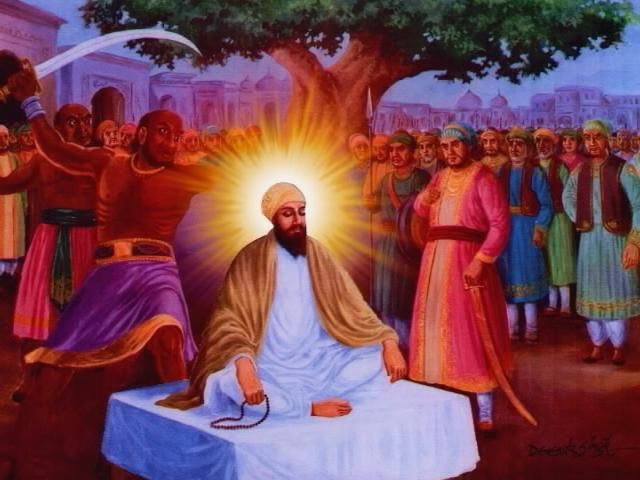Tegh Bahadur – The mighty with the Sword; Guru Tegh Bahadur was given this name when he showed extraordinary valour in the fight against Mughals. A mighty warrior, an undisputed leader, a meditating ascetic, the epitome of sacrifice, the list of greatness of his being is endless. We know him as “Hind ki chadar”.
Guru Tegh Bahadur was the ninth guru of the Sikhi. A spiritual magnet, Guru Tegh Bahadur attracted followers in thousands wherever he traveled. In addition, his life was dedicated to service of others. His major contribution was towards protecting the tormented Kashmir Hindus when religious tortures on Kasmiri Hindus were touching inhuman levels. Guru Tegh Bahadur resisted persecution and conversion of Kashmiri Hindus. Back then Kashmir was a major centre of Hinduism and and religious bigot Aurangzeb wanted to converted all Kashmiris to Islam.
India was witnessing one of the darkest times during the reign of emperor Aurangzeb. He was a cruel man who killed his elder brother for the throne, tortured his own children and had starved his father to death. Guru Tegh Bahadur had become a socio-political challenge to the Muslim rule and Aurangzeb.The Sikh movement was rapidly growing in the rural Malwa region of Punjab, and the Guru was openly encouraging Sikhs to, “be fearless in their pursuit of just society: he who holds none in fear, nor is afraid of anyone, is acknowledged as a man of true wisdom”, a statement recorded in Adi Granth 1427, statement that still gives his followers strength to stand up against social injustice.
Guru Tegh Bahadur was summoned to Delhi by Aurangzeb on the pretext to talk, but when he arrived, he was offered, “to abandon his faith, and convert to Islam”. Guru Tegh Bahadur challenged Aurangzeb that before converting Kashmir Hindus he would have to convert Guru Tegh Bahadur first. He and his associates were arrested and were tortured for weeks to force them into conversion and eventually executed. Bhai Mati Das was sawed into pieces and Bhai Dayal Das was thrown into a cauldron of boiling water, while Guru Tegh Bahadur was held inside a cage to watch his colleagues suffer. The Guru himself was beheaded on 24 November 1675 before public in Chandni Chowk, Delhi. Owing to his grand sacrifice he was named “Hind ki Chadar” ;The protective cover of Hind.
The Gurdwara Sis Ganj Sahib in Chandni Chowk, Delhi, was built on the spot where he was beheaded.
Gurdwara Sisganj Sahib in Punjab marks the site where in November 1675, the head of the martyred Guru Teg Bahadar which was brought by Bhai Jaita (renamed Bhai Jivan Singh according to Sikh rites) in defiance of the Mughal authority of Aurangzeb was cremated here.
The execution hardened the resolve of Sikhs against Muslim rule and the persecution. If the martyrdom of Guru Arjan had helped bring the Sikh Panth together, Guru Tegh Bahadur’s martyrdom helped to make the protection of human rights central to its Sikh identity.
The 9 year old son of Guru Tegh Bahadur became the 10th Guru of Sikh religion, we know him as the Great Guru Gobind Singh; another spiritual master and a valiant hero who further organised Sikh community against religious injustice.
Today marks his martyrdom day. Kashmiris and Indians will forever remain indebted to Sikh Guru Tegh Bahadur for his ultimate sacrifice. Let us remember his messages of courage and compassion. May his teachings guide us all.
